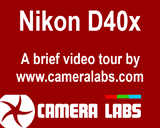Nikon D40x
-
-
Written by Gordon Laing
Intro
The Nikon D40x is a 10.2 Megapixel entry-level digital SLR aimed at general consumers, family users and photographic students. Announced in March 2007, it comes only four months after the launch of the 6 Megapixel D40, and indeed the new D40x is essentially identical other than a higher resolution sensor – and a higher price to reflect it.
Nikon says the D40x is therefore designed as a step-up for anyone who loved the D40 but was put off by its lower resolution, although clearly it’s also now a direct rival for Canon’s massively successful EOS 400D / XTi.
In Nikon’s own words, the D40x can be thought of as a D40 outer with a D80 inner. The body and controls are identical to the D40 and as far as we understand, the sensor and shutter mechanism are taken directly from the higher-end D80. By borrowing the D80’s sensor and shutter, the D40x also inherits a broader ISO range starting at 100 rather than 200 ISO, along with an increase in continuous shooting from 2.5 fps to 3 fps. Sadly it also means the D40’s impressive 1/500 flash sync speed has now become a somewhat average 1/200 on the D40x.
Despite sharing the same sensor as the D80 though, the images aren’t identical. The D40x applies the D40’s image processing to deliver brighter and sharper, more consumer-friendly JPEGs than the D80 by default (although you can of course tweak the settings). The D40x’s RAW files are also slightly different to the D80s thanks to its different image processor, so you’ll additionally need up-to-date software to process them.
These slight variations aside though, it’s fair to describe the D40x as a 10.2 Megapixel D40. As such it addresses marketing concerns over the D40’s lower resolution and provides more latitude for cropping – although as we illustrated in our Nikon D40 review, 6 Megapixels are still more than enough for a decent-looking large print. As mentioned earlier it also crucially pitches the D40x on a level playing field against the Canon EOS 400D / XTi, so the big question is how do they compare?
In our Nikon D40x full review we’ll answer that question by comparing its output against Canon’s top-selling model, while also examining the differences in features. After all, while the D40x may now match the potential resolving power of the Canon 400D / XTi, it still shares the limitations of its predecessor, including a basic three-point AF system, no depth-of-field preview, and reliance on modern lenses for auto-focusing.
 |
So is an increase in resolution alone sufficient to topple the 400D / XTi from its top-selling pedestal, or is the D40x simply an entry-level DSLR with aspirations beyond its station? Ultimately is it worth paying the extra just for the jump from 6 to 10.2 Megapixels? Find out in our Nikon D40x full review and check out our Nikon D40x video tour for an overview of its highlights. And to see how the supplied Nikkor DX 18-55mm II kit lens compares against other options, check out our Nikkor DX kit lens group test.
Note: due to similarities with its predecessor, our design and features pages are based on our earlier Nikon D40 review and updated where there’s differences. Our results, gallery and verdict pages, along with the video tour are of course completely new though.
Testing notes
The model tested was a final production unit, running firmware version 1.00. Following our convention of using default factory and best quality JPEG settings to test camera bodies unless otherwise stated, the D40x was set to Large Fine JPEG mode and sRGB, with Auto White Balance, 3D Matrix metering and the Optimise Image parameter set to Normal for sharpening, tone, colour, saturation and hue; Noise Reduction was set to its default Off setting.




